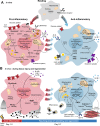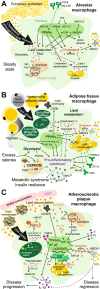Metabolism of tissue macrophages in homeostasis and pathology
- PMID: 34876704
- PMCID: PMC8891297
- DOI: 10.1038/s41423-021-00791-9
Metabolism of tissue macrophages in homeostasis and pathology
Abstract
Cellular metabolism orchestrates the intricate use of tissue fuels for catabolism and anabolism to generate cellular energy and structural components. The emerging field of immunometabolism highlights the importance of cellular metabolism for the maintenance and activities of immune cells. Macrophages are embryo- or adult bone marrow-derived leukocytes that are key for healthy tissue homeostasis but can also contribute to pathologies such as metabolic syndrome, atherosclerosis, fibrosis or cancer. Macrophage metabolism has largely been studied in vitro. However, different organs contain diverse macrophage populations that specialize in distinct and often tissue-specific functions. This context specificity creates diverging metabolic challenges for tissue macrophage populations to fulfill their homeostatic roles in their particular microenvironment and conditions their response in pathological conditions. Here, we outline current knowledge on the metabolic requirements and adaptations of macrophages located in tissues during homeostasis and selected diseases.
Keywords: Tissue macrophages; homeostasis; metabolism; pathology; tissue regeneration.
© 2021. The Author(s).
Conflict of interest statement
The authors declare no competing interests.
Figures




Similar articles
-
Emerging nanomaterials targeting macrophage adapted to abnormal metabolism in cancer and atherosclerosis therapy (Review).Int J Mol Med. 2024 Feb;53(2):13. doi: 10.3892/ijmm.2023.5337. Epub 2023 Dec 8. Int J Mol Med. 2024. PMID: 38063240 Free PMC article. Review.
-
Metabolic regulation of macrophages in tissues.Cell Immunol. 2018 Aug;330:54-59. doi: 10.1016/j.cellimm.2018.01.009. Epub 2018 Jan 17. Cell Immunol. 2018. PMID: 29395037 Review.
-
Metabolic Adaptations and Functional Activity of Macrophages in Homeostasis and Inflammation.Biochemistry (Mosc). 2024 May;89(5):817-838. doi: 10.1134/S0006297924050043. Biochemistry (Mosc). 2024. PMID: 38880644 Review.
-
Macrophage Responses to Environmental Stimuli During Homeostasis and Disease.Endocr Rev. 2021 Jul 16;42(4):407-435. doi: 10.1210/endrev/bnab004. Endocr Rev. 2021. PMID: 33523133 Free PMC article.
-
Metabolic Regulation of Macrophage Polarization in Cancer.Trends Cancer. 2019 Dec;5(12):822-834. doi: 10.1016/j.trecan.2019.10.007. Epub 2019 Nov 6. Trends Cancer. 2019. PMID: 31813459 Free PMC article. Review.
Cited by
-
The Influence of Metabolism on Immune Response: A Journey to Understand Immunometabolism in the Context of Viral Infection.Viruses. 2023 Dec 9;15(12):2399. doi: 10.3390/v15122399. Viruses. 2023. PMID: 38140640 Free PMC article. Review.
-
TREM-1 triggers necroptosis of macrophages through mTOR-dependent mitochondrial fission during acute lung injury.J Transl Med. 2023 Mar 6;21(1):179. doi: 10.1186/s12967-023-04027-4. J Transl Med. 2023. PMID: 36879273 Free PMC article.
-
Oncostatin M Induces Lipolysis and Suppresses Insulin Response in 3T3-L1 Adipocytes.Int J Mol Sci. 2022 Apr 23;23(9):4689. doi: 10.3390/ijms23094689. Int J Mol Sci. 2022. PMID: 35563078 Free PMC article.
-
Mitochondrial Fragmentation Promotes Inflammation Resolution Responses in Macrophages via Histone Lactylation.Mol Cell Biol. 2023;43(10):531-546. doi: 10.1080/10985549.2023.2253131. Epub 2023 Oct 11. Mol Cell Biol. 2023. PMID: 37807652 Free PMC article.
-
Maresin-1 promotes neuroprotection and prevents disease progression in experimental models of multiple sclerosis through metabolic reprogramming and shaping innate and adaptive disease-associated cell types.bioRxiv [Preprint]. 2024 Jun 19:2023.09.25.559216. doi: 10.1101/2023.09.25.559216. bioRxiv. 2024. PMID: 37808700 Free PMC article. Preprint.
References
Publication types
MeSH terms
Grants and funding
- ERC-2016-Consolidator Grant 725091/EC | EU Framework Programme for Research and Innovation H2020 | H2020 Priority Excellent Science | H2020 European Research Council (H2020 Excellent Science - European Research Council)
- B2017/BMD-3733 Immunothercan-CM/Comunidad de Madrid
- 201723/Fundació la Marató de TV3 (TV3 Marathon Foundation)
- Retaining Junior Leader/"la Caixa" Foundation (Caixa Foundation)
- LCF/BQ/IN17/11620074/"la Caixa" Foundation (Caixa Foundation)
LinkOut - more resources
Full Text Sources
Medical

